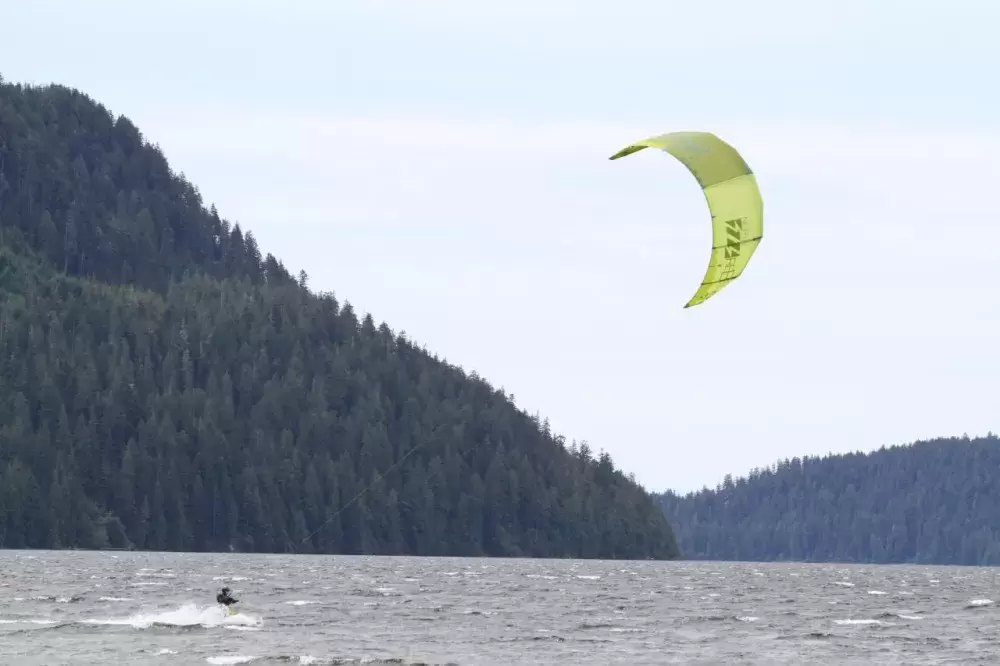While resorts along the west coast lure crowds of visitors to Tofino and Ucluelet this summer, the Ditidaht First Nation plans to attract a less intrusive form of tourism that can help support its community on Nitinaht Lake.
Brian Cofsky, who serves as executive director of the Ditidaht Economic Development Corporation, said that the Nation’s long term goal is eco-tourism that takes advantage of the natural environment. Eco-tourism is considered a smaller-scale alternative to the standard commercial approach to luring visitors, a method that conserves the pristine quality of a natural environment while benefiting its local inhabitants.
Since 2014 the Ditidaht have benefitted from fostering low-impact visitation by hosting the third entrance to the West Coast Trail. Tents were erected along the trail for hikers with lighter packs, while four Ditidaht members serve as guardians to ensure their territory is appreciated and used respectfully as thousands traverse the route each year.
“That’s really increased the tourism numbers in the last little while,” said Cofsky, who has seen a growing usage of the canvas tents since they were introduced. “The comfort camping has pretty much doubled every year since we started it.”
Inland from the trail sits Nitinaht Lake, a large salt water attraction that hosts a dependable thrust of thermal wind, making the lake one of Canada’s biggest destinations for kiteboarding.
Marty Dovick has been teaching the sport on Nitinaht for the last five years.
“This is one of the best locations worldwide. We are very, very lucky,” said Dovick, who manages Strong Kiteboarding. “We get very consistent wind here in the 20-30 knot range. It’s very steady wind, it happens on a daily basis. It’s calm in the morning and it gets calm in the night. We have small waves, the water is fairly warm relative to the rest of Canada. We’re getting 20-degree-plus water here in the lake, so it’s a very friendly, safe easy learning environment.”
“It’s always been a windsurf lake, it’s been very big in the windsurfing industry,” added Cofsky. “Every year we have hordes of windsurfers and of course now there’s kiteboarders coming to the lake, so that’s increasing the numbers.”
As Nitinaht is accessible by a mostly gravel 74-kilometre road running south of Port Alberni, the lake’s kiteboarders usually camp on a site the Dititdaht manage. Dovick has seen the campsite attract the kiteboarding community’s nomads who split their time between B.C.’s west coast and the Baha Peninsula in Mexico.
“There’s a very big section of kiteboarding instructors that kind of travel around the world, chase the wind depending on seasonal location,” he said. “Once school’s over into July, this place will be loaded. There will be over 100 people here. A busy day will be 100-plus kites on the lake and 50 windsurfers on the lake, plus their families, their dogs and everybody else up here.”
An expansion to the campsite depends on discussions the Ditidaht is holding with a logging company that owns the adjacent property.
“We are actually in negotiations with Island Timberlands to acquire those lands,” noted Cofsky. “If we can acquire them for a reasonable price, then it’s something that we will look at expanding.”
Elsewhere on the lake potential lies with the 350-hectare Doobah site, a popular spot among locals for fishing.
“We’ve just acquired those lands through an interim treaty measure,” said Cofsky. “It used to be an old Malloch & Moseley Logging camp and an old cannery years ago.”
The First Nation has recently completed a feasibility study on the area with the federal department of Indigenous affairs. Cofsky said that despite some local resistance to development, tapping into tourism at Doobah is inevitable.
“In the short term we want to be able to offer a little bit more amenities for the fishermen that are there now and be able to charge,” he said, adding that building a lodge on the site is the long-term plan.
With a quota of 8,000 hikers annually on the West Coast Trail, the Ditidaht Economic Development Corporation hopes divert some of the route’s potential users to the Hobiton Lake chain, offering a 38-kilometre journey using a network that runs off of the Nitinaht River.
“It’s a circular journey that’s part hike and part canoe,” described Cofsky.
While eco-tourism offers the Ditidaht potential for sustainable permanent jobs, the Nation’s economic development office expects that for the time being more revenue will come from forestry and small-scale hydro projects.
“That sort of revenue stream is going to allow us the long-term goal of eco-tourism,” said Cofsky.
Dovick would enjoy more business from increased development around Nitinaht Lake, but he admits that part of the area’s appeal comes from its relative seclusion compared to other kiteboarding destinations like Squamish.
“As soon as they get Internet down here all of the kids will be walking around with their cell phones, it’s going to change very much, but that’s inevitable,” he said. “It’s a double-edged sword…the users of the lake kind of like it being low-key, relaxed and almost self-policing.”







